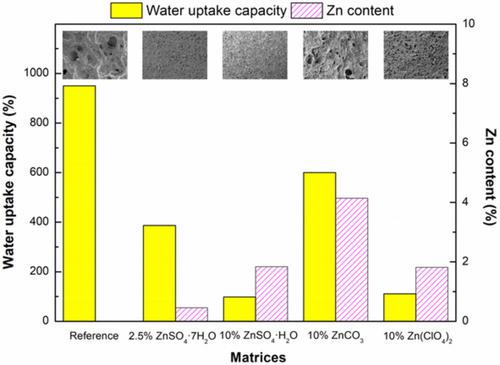当前位置:
X-MOL 学术
›
Polym. Eng. Sci.
›
论文详情
Our official English website, www.x-mol.net, welcomes your feedback! (Note: you will need to create a separate account there.)
Functional biodegradable protein‐based matrices as a potential candidate for micronutrients and water supply
Polymer Engineering and Science ( IF 3.2 ) Pub Date : 2020-07-08 , DOI: 10.1002/pen.25471 Mercedes Jiménez‐Rosado 1 , Adrián Martín 1 , María Alonso‐González 2 , Antonio Guerrero 1 , Alberto Romero 2
Polymer Engineering and Science ( IF 3.2 ) Pub Date : 2020-07-08 , DOI: 10.1002/pen.25471 Mercedes Jiménez‐Rosado 1 , Adrián Martín 1 , María Alonso‐González 2 , Antonio Guerrero 1 , Alberto Romero 2
Affiliation

|
The excessive use of fertilizers in horticulture applications generates subsoil and groundwater contamination due to their high solubility. A possible solution to this problem is the incorporation of nutrients in biodegradable matrices, allowing nutrients to be released in a controlled manner depending on the needs of the crops. The principal objective of this work was the evaluation of the incorporation of different salts into soy protein‐based matrices to develop devices that could release micronutrients in a controlled manner. Thus, the processability of matrices with different incorporated salts such as zinc sulfate heptahydrate (ZnSO4·7H2O), zinc sulfate monohydrate (ZnSO4·H2O), zinc carbonate (ZnCO3), and zinc perchlorate (Zn(ClO3)2), as well as their integrity and functionality have been evaluated. Results show the great potential of soy protein‐based matrices for the incorporation of micronutrients such as zinc. However, salt incorporation has a detrimental effect on the water uptake capacity of the matrices.
中文翻译:

功能性可生物降解的蛋白质基基质可作为微量营养素和供水的潜在候选者
由于园艺肥料的高溶解度,在肥料中过度使用会产生土壤和地下水污染。解决此问题的一种可能方法是将营养物掺入可生物降解的基质中,从而根据作物的需要以受控的方式释放营养物。这项工作的主要目的是评估将不同的盐掺入基于大豆蛋白的基质中,以开发出可以以受控方式释放微量营养素的装置。因此,具有不同掺入盐的基质的可加工性,例如七水合硫酸锌(ZnSO 4 ·7H 2 O),一水合硫酸锌(ZnSO 4 ·H 2 O),碳酸锌(ZnCO 3)和高氯酸锌(Zn(ClO 3)2),以及它们的完整性和功能性已得到评估。结果表明,基于大豆蛋白的基质具有掺入微量营养元素(如锌)的巨大潜力。但是,盐的掺入对基质的吸水能力有不利影响。
更新日期:2020-09-16
中文翻译:

功能性可生物降解的蛋白质基基质可作为微量营养素和供水的潜在候选者
由于园艺肥料的高溶解度,在肥料中过度使用会产生土壤和地下水污染。解决此问题的一种可能方法是将营养物掺入可生物降解的基质中,从而根据作物的需要以受控的方式释放营养物。这项工作的主要目的是评估将不同的盐掺入基于大豆蛋白的基质中,以开发出可以以受控方式释放微量营养素的装置。因此,具有不同掺入盐的基质的可加工性,例如七水合硫酸锌(ZnSO 4 ·7H 2 O),一水合硫酸锌(ZnSO 4 ·H 2 O),碳酸锌(ZnCO 3)和高氯酸锌(Zn(ClO 3)2),以及它们的完整性和功能性已得到评估。结果表明,基于大豆蛋白的基质具有掺入微量营养元素(如锌)的巨大潜力。但是,盐的掺入对基质的吸水能力有不利影响。


























 京公网安备 11010802027423号
京公网安备 11010802027423号